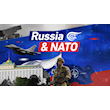European confusion clouds the Ukraine post-war security plan
European nations discussing post-war Ukraine security plans have come to a standstill regarding whether deterrence or peacekeeping must be prioritized.
-

A Ukrainian police officer takes cover in front of a burning building that was hit in a Russian airstrike in Avdiivka, Ukraine, Friday, March 17, 2023. (AP)
European nations are considering sending troops to Ukraine if a ceasefire is implemented after US President-elect Donald Trump affirmed that no American soldier would be deployed in Kiev, Reuters reported.
The discussions, led by French President Emmanuel Macron, are still in the early stages. However, they have already exposed divisions regarding the potential objectives and mandate of such a mission, as well as the timing of raising the issue.
According to Reuters, European leaders aim to prevent Russian President Vladimir Putin from thinking that negotiations are imminent or that he will retain his battlefield gains, emphasizing their commitment to increasing military and economic support for Ukraine.
However, behind the scenes, some officials are exploring ways to offer security guarantees to Ukraine, potentially by deploying tens of thousands of soldiers on Ukrainian territory. This could involve European forces being deployed to Ukraine, whether Kiev secures a security guarantee through NATO membership, as it desires, or through bilateral agreements.
The European conundrum
While it was expected that France, Germany, Italy, Poland, and Britain could form the bulk of the force, certain European nations expressed their aversion or hesitancy regarding such a move, including Poland, which declared that it did not intend to participate.
Meanwhile, German Defense Minister Boris Pistorius said that Berlin would play a role in securing a ceasefire agreement in Ukraine but was yet to outline what kind of force would be needed in Kiev post-establishment.
Analysts noted that the inter-European debate has highlighted uncertainty over the role of the future European mission, with Italian officials emphasizing peacekeeping, while French and Ukrainian officials concentrating on deterrence.
In this context, a deterrence force could be formed by a coalition of five to eight countries, according to a Ukrainian official involved in the discussions. Estimates of the force's size vary, with some analysts suggesting around 40,000 troops could be feasible, depending on the mission's specifics.
Under a rotation system, which would involve units preparing for and recovering from deployments, up to 100,000 troops could be involved in the mission at any given time, according to Franz-Stefan Gady, an Austrian former military planner at the International Institute for Strategic Studies.
Previously, Britain and France were reportedly in confidential talks, according to a report by Mirror, to explore the potential deployment of their troops to Ukraine as part of a ceasefire monitoring initiative. According to a senior NATO official cited in the report, these discussions are being held in London and Paris, "not at the NATO level."
One proposed scenario involves "an Anglo-French contingent patrolling the contact line between Ukraine and Russia in order to monitor a ceasefire that may be achieved as a result of peace talks."
The cited official noted that such preparations aim to ensure European involvement in mediation efforts that Trump could lead.

 3 Min Read
3 Min Read









